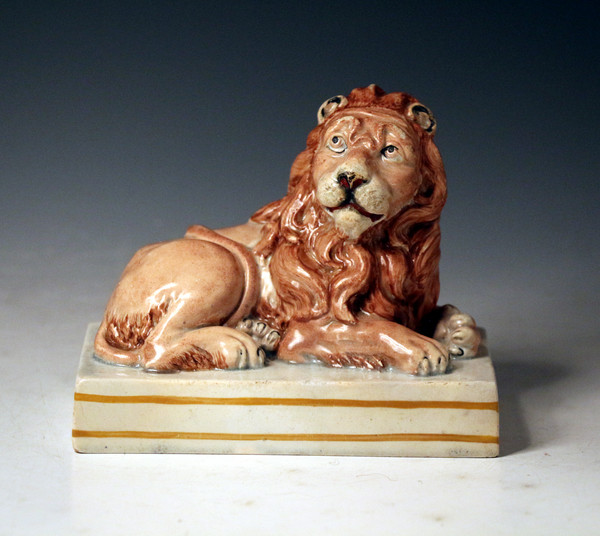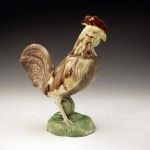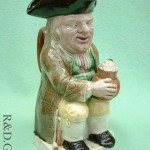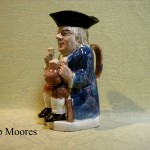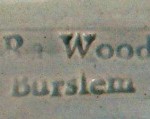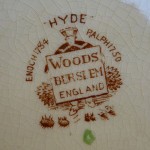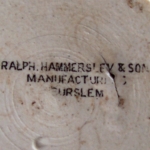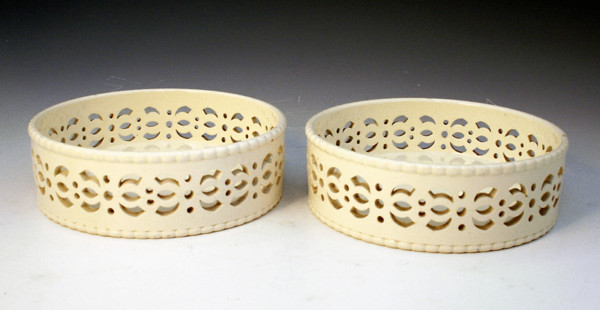The Wood Family
The Wood family a major force in the development of Staffordshire wares from peasant pottery to an organized industry, they were a celebrated family of potters.
- Ralph Wood 1715-72 “the miller of Burslem”
- Aaron Wood 1717-85 (Ralph’s brother)
- Ralph Wood Jr. 1748-95 (Aaron’s son) through his mother he was related to Josiah Wedgwood.
- John Wood 1746-97 (Ralph Jr.’s brother) – In 1787 John started his own pottery at Brownhills.
- Ralph Wood III 1781-1801 .. continued the firm after his father’s death.
- William Wood 1746-1808 (Aaron’s son) was employed as a modeler by Wedgwood.
- Enoch Wood 1759-1840 (Aaron’s son) apprenticed with Wedgwood – later established in Burslem as an independent potter in partnership with his cousin Ralph Wood
Ralph Wood: In 1730 he was apprentice to John Astbury, and later worked with Thomas Whieldon at Fenton Low, learning the manufacture of coloured glazes.
By about 1760 Ralph Wood was making extremely well-modelled figures with coloured glazes. Subjects were in great variety; the best is probably the equestrian “Hudibras” glazed in manganese and orange. The “Vicar and Moses appeared at this time and enjoyed great popularity.
Wood was among the first of English potters to impress his name on his wares (Specimens made by the Woods, father and son, are sometimes impressed with a name, R. WOOD or R. WOOD BURSLEM). He is credited with introducing the Toby jug, his first model of the kind being “Toby Philpot” about 1762.
Aaron Wood: was apprenticed with the Thomas Wedgwood, Jr., firm from 1731 to 1746, when he left to work with Whieldon. He opened his own pottery four years later.
Ralph Wood Jr.: produced many figures, both from his father’s moulds and from new ones of a variety of subjects. His figures were coloured with enamels instead of glazes, and many were impressed with the mould number in the base. An extant invoice shows him supplying figures to Josiah Wedgwood in 1783.
Enoch Wood: was apprenticed with Wedgwood for a time and later with Humphrey Palmer.
By 1783 Enoch was established in Burslem as an independent potter in partnership with his cousin Ralph Wood, and in 1790 he entered a partnership with James Caldwell, when the style of the firm became Wood & Caldwell.
In 1818 Enoch Wood continued alone, under the style Enoch Wood & Sons.
The firm made all the wares that were current in Staffordshire at the time, including black basaltes, jasper, and probably porcelain. Large quantities of blueprinted earthenware were produced, much of which was exported to the United States. Busts modeled by Enoch Wood himself are fairly numerous.
The Wood factory closed in 1846.
Ralph Wood II and Ralph Wood III (active 1782-1801)
Halfpenny’s viewpoint has now been displaced by the rigorous research by Wynne Hamilton-Foyn. [ii] Hamilton Foyn’s work proves that from August 1782 until his death in 1795 Ralph Wood II produced figures that he had almost certainly modeled himself. In summary, we now know the following about Ralph Wood II:
- In 1769, aged 21, he completed his apprenticeship and was hired by Thomas and John Wedgwood of the Big House. Here his father, Ralph Wood I, worked as a modeler.
- Ca. 1772- 1773 he established a Burslem manufactory with his brother John but the venture failed in 1773.
- From 1773, he operated with John an upscale earthenware and glass shop in Bristol, where he sold the wares of others.
- In June 24, 1774, he married Sophia Lambert
- In May 29, 1774, his son, Ralph Wood III, was baptized at two weeks of age.
- In 1775, his brother John returned to Burslem to work at the Big House Pottery, which supplied wares to the Bristol shop.
- In August 1781, he was accused of sodomy and considered fleeing Bristol.
- In September, 1781, his Bristol goods were sold at bankruptcy auction.
- By March 1782, he had returned to Burslem.
- On August 14, 1782, he invoiced Josiah Wedgwood for figures (with titles familiar to collectors). This invoice evidences his presence in Burslem as a manufacturer in 1782.
- In July 28, 1783, he again invoices Wedgwood for similar wares. Subsequent invoices dated September 5, and November 19, 1783, further support his continued presence as an independent manufacturer of figures.
What of the long-held belief that RW was sales manager in a partnership with EW from 1783-1789? The Enoch Wood papers acquired by the Potteries Museum in 2005 relegate this to the realm of myth. Enoch Wood notes “I began business for myself Nov 11th 1783 with partner Ralph Wood for a few weeks only dismiss [sic] him with all his things again”. The underlining is Enoch’s. Clearly this relationship was short-lived. Ralph had significant “things” to contribute to the partnership because he had been an established manufacturer for over a year.
What of the hypothesis that Enoch made the Ralph Wood figures? From the above, we know Enoch could not have made Ralph’s figures between 1783 and 1789 because Ralph was making them. Enoch could not have made them before 1783 because he was working for Neale at the Church Works, Hanley. Thus, Enoch could not have made the wares Ralph Wood supplied to Wedgwood in 1782.
What of the theory that John Wood made the Ralph Wood figures? Firstly no figure bears a John Wood mark, while the Ralph Wood mark has been recorded frequently. Secondly, John Wood’s manufactory opened in May 1783, a date later than that on the earlier invoices Ralph submitted to Wedgwood. Clearly, Ralph Wood was an established manufacturer when John opened his doors. While John did sell figures subsequently, they were a small part of his sales and were probably supplied by Ralph. Ralph and John were brothers. John had helped Ralph financially in the past and it is unlikely that he would have competed in figure production with his brother.
What of the hypothesis that Ralph Wood modeled nothing but bought his models from others? Frank Falkner, writing in 1912, strongly believed that RW was, like his father, a modeler. He gleaned this information from early family papers and oral family history. Ralph Wood I was a modeler for the Big House Wedgwoods until his death in 1772. Ralph Wood II worked at the Big House at least from 1769, when he finished his apprenticeship, and it seems reasonable to believe he acquired modeling skills from his father. Ralph Wood II’s childhood was dominated by modeling. His father, Ralph I, and uncle, Aaron, were leading modelers of their time; his cousin William was to become a leading modeler for Wedgwood; his cousin Enoch was a renowned modeler; and his sister Mary married a modeler. Models for the making of molds were expensive. If you could make them in-house, you did—especially if you were cash-strapped, as Ralph Wood II frequently was. Ralph Wood’s ability to fashion his own models explains the extraordinary range of Ralph Wood figures, as well as variations of the same figures. Again and again, we see models adaptations giving rise to a different form of the same figure: “Hay Maker” (impressed 31) occurs with different heads; multiple versions of gardeners, Venus, Jupiter, and other figure forms occur. The ability to create models reduced the need for capital, and this skill was probably critical to Ralph Wood II being able to start his own manufactory just months after his bankruptcy. Hamilton Foyn concludes that strong circumstantial evidence makes it likely that Ralph Wood was creating models in his Bristol shop and was ready to go into production when he returned to Burslem in 1783.
What of Ralph Wood III? After the death of his father in 1795, he continued the Hill Potworks until his own death at the age of 26 in 1801. There is no way of knowing which Ralph Wood figures were made by Ralph Wood III. But we do know that all Ralph Wood figures were made no later than 1801. As such, they fall into what Halfpenny dubs “The First Phase” of enamel figure production (1780-1800). But Halfpenny classifies some Ralph Wood figures as Second Phase (1800-1840)[iii], based on her subjective assessment of their enamel palette. As both Ralph Woods were dead within months of the start of the Second Phase, the validity of this subjective classification must be questioned.

